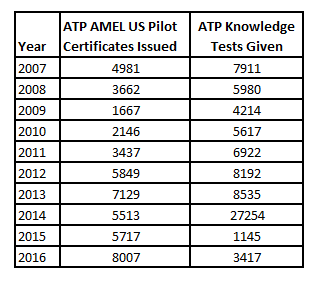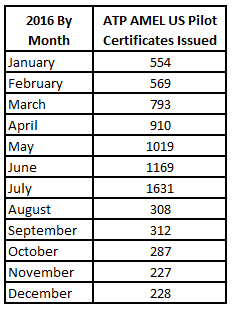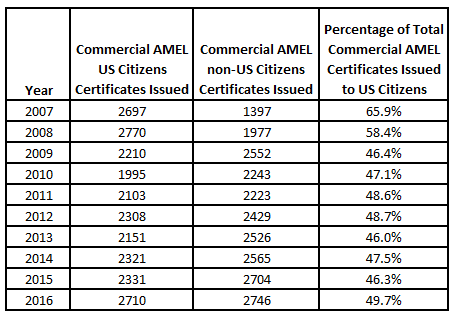Recent data from the FAA empirically indicates that we are experiencing a declining trend in US Commercial Multi-Engine pilot and ATP certificates being issued. There are many motivations for whether people choose to become pilots and seek professional employment in the field, and while I am not going to go into that here, there is important data relevant to pilot capacity discussions as we consider current testing and certification trends.
The number of ATP practical tests being administered in the U.S. is declining significantly following two years of declining numbers in the number of ATP Knowledge Tests. While the number of commercial multi-engine pilot certifications has remained flat, the percentage of tests being completed by U.S. pilots is dropping. These two trends mean fewer U.S. pilots qualified for ATP certification and for future employment by U.S. airlines.
These trends are partially the result of changes in FAA certification regulations over the past years that impacted what steps a pilot must complete in order to be ATP certificated. While other industry factors are also at play, and many will contend that pay is a major factor here, the direct correlation to the reductions in certification by U.S. pilots has tracked in line with the changes in certification requirements that were implemented.
On August 1st, 2014, it became mandatory that anyone who taking a FAA ATP Knowledge Test has completed a specific ATP CTP training course, of which there are only a few providers and for which the cost is significant. Pilots who had completed the test prior to this date had a grace period of 24 months until their test was no longer valid, and on August 1st, 2016 this expired. In the first half of 2014, we saw a surge of pilots taking their FAA ATP Knowledge Tests prior to that deadline, and as we expected, in 2016 we saw a surge of pilots completing their FAA ATP Practical Tests in the first half of 2016. Since then, we have seen a significant decrease in monthly volume of ATP practical tests.
Considering testing volume numbers provided by the FAA, it appears we are on a good path to increase our yearly flow, with 2016 being the biggest year in recent history for ATP AMEL U.S. Pilot Certificates being issued. With more context, we see that the same thing happened in 2014 when there was a deadline for taking the FAA ATP Knowledge Test and then in 2015 we saw an incredible drop in the rate of testing for the knowledge test.

Taking this analysis a little bit deeper, month-by-month numbers for ATP AMEL US Pilot Certificates issued show the same trend that happened up to and beyond the August 1st, 2016 practical test deadline with a large drop-off after that deadline.
Looking more closely at the number of tests given in the months between August and December of 2016, we have seen an average of approximately 272 ATP practical tests being given per month. If this represents our new average monthly volume, it would mean instead of somewhere greater than 5000 ATP multi-engine certificates being issued per year, we would more likely expect something like 3264 ATP certificates to be issued per year, a greater than 30% decrease.
In addition to reducing numbers of ATP practical tests being given, we have experienced a change in the ratio of multi-engine commercial pilot certificates being issued to US citizens versus non-US citizens. Many know that the United States, with our open and extremely safe training environment, is a significant provider of flight training to many of the world’s future pilots. These pilots come to the United States to complete their initial pilot certifications before heading back home to complete airline focused and/or type rating training to serve in overseas airline operations. This is a significant part of the business part of flight training operations in the United States, and it has been growing. But at the same time, the pure number of US pilots who are completing multi-engine commercial pilot certificates has actually been decreasing.
The above data shows that while our overall multi-engine commercial pilot certificates issued on a yearly basis has not significantly changed, who they are being issued to is changing. Most of the individuals who are non-US citizens who complete these certificates transition back out of the United States for their pilot careers and are not available to US commercial operators to fill needed pilot positions. On a side note, it is critical that we keep our training environment attractive as a source for training for other nations because these individuals who get trained here in the United States provide valuable student hours for instructors working at the training operations who need to build flying experience to themselves become qualified for ATP certificate minimum experience levels.
Why is this important you may ask? Well, if there are fewer multi-engine commercial pilots from the United States, it means there are fewer qualified pilots who can become ATP certificated. As this flow decreases it will additionally affect our pool of prospective future pilots who may fly for our domestic airlines.
Considering the two factors of declining US AMEL Commercial pilot certificate issuance and declining ATP pilot certification numbers, we are left with the logical conclusion that we will see fewer available pilots who will meet airline employment requirements. This trend will continue unless more pilots complete these certifications in the future.



Jason,
I’m writing a paper on the economics of the proposed pilot shortage and ran across your data. I was curious if you knew your source for the data you used as the numbers appear to be off from the ones I’m seeing from the FAA
https://www.faa.gov/data_research/aviation_data_statistics/civil_airmen_statistics/
The numbers I have provided here were directly from the Airman Certification office of the FAA and have not been published yet on the data that you were referencing. They are more current numbers from the past year or so.